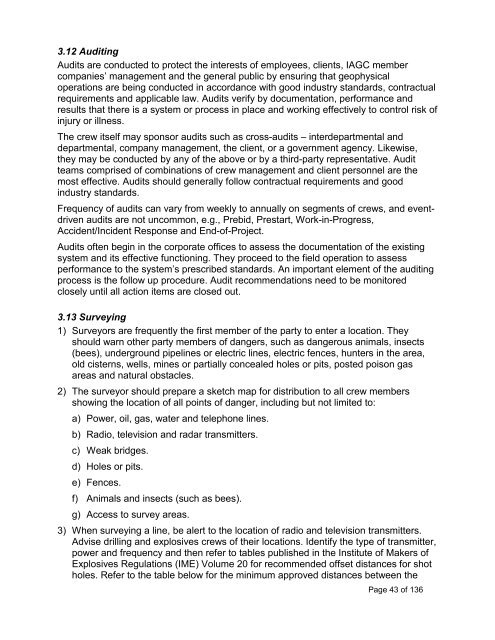IAGC LAND GEOPHYSICAL SAFETY MANUAL Edition 9 ... - CGISS
IAGC LAND GEOPHYSICAL SAFETY MANUAL Edition 9 ... - CGISS
IAGC LAND GEOPHYSICAL SAFETY MANUAL Edition 9 ... - CGISS
- No tags were found...
Create successful ePaper yourself
Turn your PDF publications into a flip-book with our unique Google optimized e-Paper software.
3.12 AuditingAudits are conducted to protect the interests of employees, clients, <strong>IAGC</strong> membercompanies’ management and the general public by ensuring that geophysicaloperations are being conducted in accordance with good industry standards, contractualrequirements and applicable law. Audits verify by documentation, performance andresults that there is a system or process in place and working effectively to control risk ofinjury or illness.The crew itself may sponsor audits such as cross-audits – interdepartmental anddepartmental, company management, the client, or a government agency. Likewise,they may be conducted by any of the above or by a third-party representative. Auditteams comprised of combinations of crew management and client personnel are themost effective. Audits should generally follow contractual requirements and goodindustry standards.Frequency of audits can vary from weekly to annually on segments of crews, and eventdrivenaudits are not uncommon, e.g., Prebid, Prestart, Work-in-Progress,Accident/Incident Response and End-of-Project.Audits often begin in the corporate offices to assess the documentation of the existingsystem and its effective functioning. They proceed to the field operation to assessperformance to the system’s prescribed standards. An important element of the auditingprocess is the follow up procedure. Audit recommendations need to be monitoredclosely until all action items are closed out.3.13 Surveying1) Surveyors are frequently the first member of the party to enter a location. Theyshould warn other party members of dangers, such as dangerous animals, insects(bees), underground pipelines or electric lines, electric fences, hunters in the area,old cisterns, wells, mines or partially concealed holes or pits, posted poison gasareas and natural obstacles.2) The surveyor should prepare a sketch map for distribution to all crew membersshowing the location of all points of danger, including but not limited to:a) Power, oil, gas, water and telephone lines.b) Radio, television and radar transmitters.c) Weak bridges.d) Holes or pits.e) Fences.f) Animals and insects (such as bees).g) Access to survey areas.3) When surveying a line, be alert to the location of radio and television transmitters.Advise drilling and explosives crews of their locations. Identify the type of transmitter,power and frequency and then refer to tables published in the Institute of Makers ofExplosives Regulations (IME) Volume 20 for recommended offset distances for shotholes. Refer to the table below for the minimum approved distances between thePage 43 of 136
















